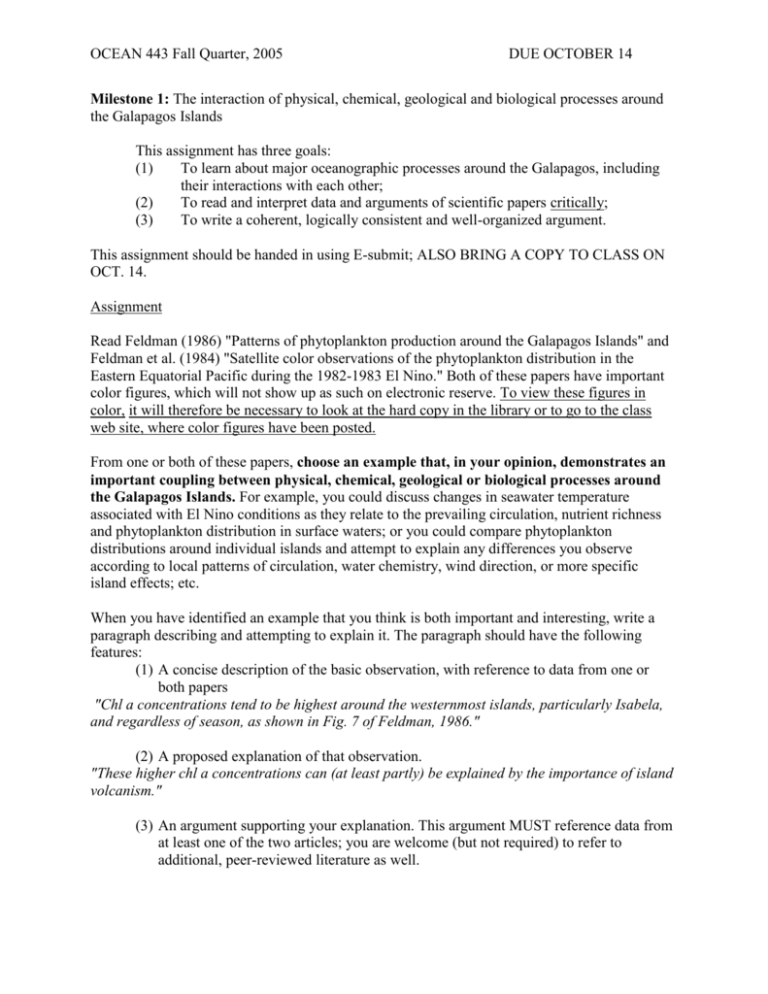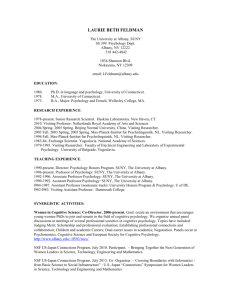Milestone 1: The interaction of physical, chemical, geological and
advertisement

OCEAN 443 Fall Quarter, 2005 DUE OCTOBER 14 Milestone 1: The interaction of physical, chemical, geological and biological processes around the Galapagos Islands This assignment has three goals: (1) To learn about major oceanographic processes around the Galapagos, including their interactions with each other; (2) To read and interpret data and arguments of scientific papers critically; (3) To write a coherent, logically consistent and well-organized argument. This assignment should be handed in using E-submit; ALSO BRING A COPY TO CLASS ON OCT. 14. Assignment Read Feldman (1986) "Patterns of phytoplankton production around the Galapagos Islands" and Feldman et al. (1984) "Satellite color observations of the phytoplankton distribution in the Eastern Equatorial Pacific during the 1982-1983 El Nino." Both of these papers have important color figures, which will not show up as such on electronic reserve. To view these figures in color, it will therefore be necessary to look at the hard copy in the library or to go to the class web site, where color figures have been posted. From one or both of these papers, choose an example that, in your opinion, demonstrates an important coupling between physical, chemical, geological or biological processes around the Galapagos Islands. For example, you could discuss changes in seawater temperature associated with El Nino conditions as they relate to the prevailing circulation, nutrient richness and phytoplankton distribution in surface waters; or you could compare phytoplankton distributions around individual islands and attempt to explain any differences you observe according to local patterns of circulation, water chemistry, wind direction, or more specific island effects; etc. When you have identified an example that you think is both important and interesting, write a paragraph describing and attempting to explain it. The paragraph should have the following features: (1) A concise description of the basic observation, with reference to data from one or both papers "Chl a concentrations tend to be highest around the westernmost islands, particularly Isabela, and regardless of season, as shown in Fig. 7 of Feldman, 1986." (2) A proposed explanation of that observation. "These higher chl a concentrations can (at least partly) be explained by the importance of island volcanism." (3) An argument supporting your explanation. This argument MUST reference data from at least one of the two articles; you are welcome (but not required) to refer to additional, peer-reviewed literature as well. OCEAN 443 Fall Quarter, 2005 DUE OCTOBER 14 "Supporting the importance of volcanism to phytoplankton distribution around the westernmost islands is the satellite observation of lava flowing from the islands into the most chlorophyll-rich regions (Plate 1a in Feldman, 1986). No similar lava flows were observed in chlorophyll-poor regions (Plate 1a). Moreover, the westernmost islands had low chlorophyll concentrations when lava was not observed flowing into the sea (Plate 1b, Feldman, 1986). Lava could enhance phytoplankton growth by warming surface waters and increasing the rate of chemical reactions." (4) A discussion of why this particular example of coupling is important (i.e. why did you choose it?) "The large number of active volcanoes in the Galapagos Islands suggests that lava-induced seasurface warming and associated enhancement of primary production may be regionally common." You will be evaluated according to the strength of your argument, including the relevance and appropriateness of the data you cite in support of it, and the overall importance of the processes you discuss to the regional oceanography (for which you must argue; part 4, above). Take care that your argument is internally consistent, supported by data that you cite and not contradicted by data in one of these two papers that you don't cite. The mock example above would fare poorly (because it’s [1] internally inconsistent [if this phenomenon explains only the westernmost islands, why conclude that it's regionally common?], [2] not supported by correctlyinterpreted data [there are no satellite observations in either paper of lava flowing into the sea] and [3] contradicted by uncited data [Fig. 3 in Feldman (1986) does not show highest chl a concentrations in warmest waters.]) If you make an argument seemingly contradicted by some data in one of these papers, but in a way that you think does not invalidate your argument, discuss it in your paragraph (e.g. "Although Fig. 15 in Feldman (1986) shows chl a values declining with lava concentration, these data were taken during Equatorial summer, when surface waters are already warm; my argument is limited to Equatorial winter, when the warming effect due to lava input is more significant."). One caveat: Be sure to distinguish data from interpretation. Citing Fig. 7 in Feldman (1986) as showing higher chl a concentrations around westernmost islands is fine; citing Fig. 7 as showing enhanced upwelling, leading to higher chl a concentrations, would be incorrect -Fig. 7 does not show this -- even if Feldman makes that argument in the paper itself. On the other hand, feel free to make inferences from data, such as "The lower sea surface temperatures (Plate 1b in Feldman, 1986) in this region are consistent with upwelling, which could bring nutrientrich waters to the surface and support higher chl a concentrations." If you have questions, contact Llyd (chimera1@ocean.washington.edu).






